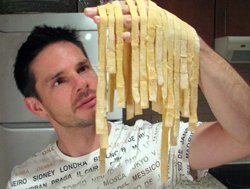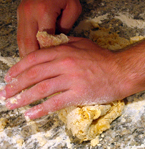STEPS 6 INGREDIENTS 3 TIME 20-25 MINS The process of making fresh pasta is truly simple, meaning you’re just 20 minutes or so away from producing the kind of super-succulent, flavour-friendly Italian pasta that you and your guests will love.
(For a video version of this page, click this how to make pasta guide.)

Making fresh pasta simply involves:
• Mixing – the 3 ingredients
• Folding – the dough
• And rolling – to flatten the pasta before shaping.
It’s way easier to make pasta dough than pizza dough (I’ve been doing the latter for years and it still goes wrong sometimes), and compared to packet pasta the real deal pasta is a revelation: it takes 5 minutes or less to cook, has a fuller taste, and it holds its sauce’s luscious flavours better than pre-packed pasta.
Serves 2
Ingredients:
250-300g/9-10oz of all-purpose/plain flour (ideally type ‘double zero’ but not essential)
2 eggs
A little salt
Equipment
Fork
Rolling pin
STEP 1 – After washing your hands, pour out a hand-sized mound of flour onto a clean kitchen worktop and use your fingers to make a ‘bowl’ out of this flour.
This bowl should measure roughly 6 or 7 inches (15cm+) across, with 1-2-inch (2.5-5) thick ‘walls’. Also, make sure the bottom of the bowl is an inch or so deep – you want to see flour there, not worktop.

STEP 2 – Using the fork, crack open the eggs into the flour bowl. Cover each egg yolk with salt.
Now pierce the yolks with the fork and very gently stir this yolk around (to mix it with the egg white a little).

After a few stirs, flatten the fork and mix the eggs more firmly – being careful not to slop the eggs out of the bowl.
STEP 3 – When the egg white and yolk are mixed into an orangey mixture, keep stirring and begin tapping flour from the highest edges of the bowl into the mixture.
This is a key task when making fresh pasta – the idea is to do it very carefully until the mixture thickens a lot.

Note: The slight danger is that you will make the bowl’s wall too thin by pushing too much flour into the centre, and the mixture will then leak out onto your surface.
Keep ‘evening up’ the walls with the side of your hand as you go. If spillage occurs however, don’t worry. Just quickly add more new flour to rebuild the wall and don’t sweat the lost stuff.
STEP 4 – When the mixture begins sticking to the worktop surface (it should be too thick to run off by now) and the walls of the bowl are thinner, remove excess flour from the walls so that they are less than an inch thick. Now pop these flour walls onto the thick mixture.
Using your fingers, mix this flour and wet mixture together for 2 or 3 minutes – until you can clump it together into a ball of dough. Add flour to make it less sticky if you need to, but don’t completely dry it out.

STEP 5 – Use your palm to flatten the dough ball, then fold it in half. Flatten it again, turn and fold it in another direction, and repeat.
This process places air inside the pasta dough, which you can see in the form of tiny bubbles/holes on its surface. I usually spend 5-7 minutes of flattening and folding before these become visible.
Give it some stick… this hammering and folding is great for relieving stress!
When your dough ball has plenty of these mini-dimples on its surface, pat it with a little flour and leave it to stand (i.e. breathe) for 5 minutes.

STEP 6 – Cover your worktop with a sprinkling of flour and grab the dough. Flatten it into a thick circle with your hands, then use the rolling pin to indent a line in its centre.
Use this as your starting point to roll the dough flat – slowly forwards and then backwards. Turn it 90-degrees left or right, and repeat. Then forget about the indent and just keep rolling away. This is the physical part of making fresh pasta, so enjoy burning some calories before you eat the next lot!

Chill! Making fresh pasta can be frustrating right about now because the dough is elastic and keeps contracting back to almost its original size. It’s just toying with you though… don’t worry.
Just keep rolling and after maybe 8 or 10 minutes, the dough will finally start to keep its larger shape. You win!
Aim for a 1mm final pasta thickness, or stop when the dough starts to stick to the surface (this is a good indicator, plus when this happens you can roll the dough out even larger without it moving around).
You’re done! Making fresh pasta is easy!
Now your pasta is ready to shape. Tagliatelle (flat strips of pasta) are the easiest to cut…

• Fold the pasta over into 3-inch (7.5cm) folds (flattening it gently after each)
• Cut it cross-ways in 1cm strips and keep on a heavily-floured plate until cooking.
What’s next?
It’s time to turn these supple strips into a winning Italian pasta dish. You have several options:
• Use this pasta to create a quick and delicious breakfast pasta.
• Alternatively, tagliatelle goes perfectly with many of the pasta sauces recipes on this site.
• Or… if you’d prefer to spend more time checking out all the pasta sauces on this site, cover your tagliatelle with kitchen paper for an hour or two.
(If you need longer, freeze your tagliatelle: space the strips evenly on aluminium foil sheets and stack in the freezer. Defrost at room temperature when required – this takes just half an hour.)